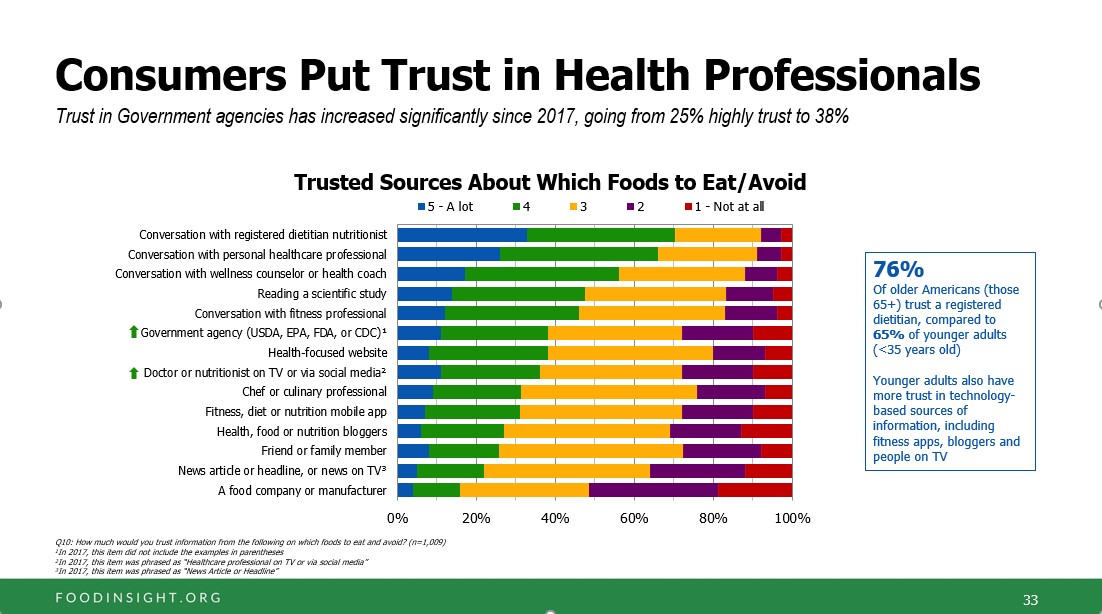BY: DANIELLE ROBERTSON RATH
As a food scientist who studies energy drinks, I know how important it is to consider consumer behaviors and fears with regards to food products. Energy drinks are controversial, so it’s not enough to study the science, but you also have to communicate it to the public. That’s why I find surveys on consumer attitudes and behaviors so fascinating. For one thing, a consumer’s attitude toward a food product or ingredient doesn’t always match their behavior toward that food or ingredient. We may understand, intellectually, that we’re supposed to eat at least 5 servings of vegetables a day but that definitely does not mean we actually follow through with it.
In May 2018, the International Food Information Council released the results of their 2018 Food and Health Survey. This survey was created from the online responses of 1009 Americans, age 18-80, weighted by age, education, gender, race/ethnicity, and region to match the US population.
“The International Food Information Council (IFIC) Foundation’s 2018 Food and Health Survey marks the 13th time the IFIC Foundation has surveyed American consumers to understand their perceptions, beliefs and behaviors around current food and food purchasing decisions.
This year, the survey continues an examination of issues related to health and diet, food components, food production, and food safety. It also explores new topics, such as food insecurity, diets and eating patterns, and how consumers’ diets compare to dietary guidelines and expert recommendations.”
This survey contains information on attitudes toward food packaging and sustainability, food labeling claims, functional food health benefits, diet trends and more. The survey questions vary little year to year to help monitor shifts in consumer responses year to year. However, this year’s survey included new topics including food insecurity, diets and eating patterns, and how consumers’ diets compare to dietary guidelines and expert recommendations.
But the part that fascinates me most is what we can learn about consumer trust based off of their responses. Where do consumers get their information? How do they make up their minds on what to eat and what to avoid? Do they trust the food they are eating is safe? What about their perception of what it means to be healthy?
Where do you get your information? Consumer Trust and Reliance
When you meet new people and tell them you study food science, how often do you get questions about whether such-and-such ingredient is safe? Or whether such-and-such ingredient really has the health benefits others claim? Or why on Earth we really need food like Oreos?
Whether I tell people I study food science, in general, or energy drinks, in particular, I usually get questions about truth, trust, and transparency. People think since I study this field, I’m “in the know” and can give them a straight answer, or clear up rumors they’ve heard but weren’t ready to believe.
For the record, no, taurine does not come from bull sperm, and yes, there really is a good reason why energy drinks (and Oreos) exist.
When we consider the responses to the Food and Health Survey, it is not surprising people are confused.. A whopping eighty percent of American consumers say there’s conflicting information about what food to eat or avoid. EIGHTY PERCENT! That seems really high, but it’s not surprising when you consider where people are getting their information. Healthcare professionals and friends/family tied as the most relied-upon sources of information for what to eat and avoid, but only a fraction of people actually believe the information they get from friends and family. This means people continue to get information from sources they don’t trust!
Of course, whether it’s solicited or unsolicited advice from friends/family is probably another matter.

Figure 1: How much people trust various sources on what to eat and avoid
Looking at the blue and green bars as measurements of trust, probably the most encouraging (but also ironic) news from this survey is how much consumers trust food bloggers – that is to say, very little. Of course, as someone who manages a blog about the science behind energy drinks, and who contributes to the blog you are reading right now, this statistic stings just a little. However, maybe this statistic isn’t entirely all bad news. After all, we live in a world where some bloggers like Food Babe spread chemophobia and fear about what’s in our food. I hope this result means more people are starting to pause and use healthy skepticism when faced with hyperbolic stories about how both bread and yoga mats bread include “dangerous chemicals” like azodicarbonamide. Context makes a difference! The difference between a poison and a cure is the dosage, according to the Father of Toxicology, Paracelsus.

Figure 2: How much a source is used versus how much it is trusted
What ingredients do you eat and avoid? Ingredient Preferences and Health Goals
Do friends, family, or significant others ever tease you about how long you spend in a grocery store? For me personally, going grocery shopping is never a quick endeavor because I can’t help myself – I always end up reading labels. Even if it’s for a food I have no intention of buying, reading the label is like taking the peak under the hood of a nice car, or walking through someone’s house: you can learn so much from this intimate inspection.
Over 50% of consumers look at the nutrition facts panel and ingredients list when making purchasing decisions. What they interpret from what they see is a different story. When consumers have to choose between two products with identical nutrition facts panels, one-third believe the product with the shorter ingredients list is heathier. If given the option between two versions of the same product – one with artificial ingredients and one without, nearly 7/10 would pick the product with no artificial ingredients. But how many times do consumers really have that choice? Any product developer can tell you changing artificial ingredients to natural is rarely as easy as this hypothetical example. Nor is it a safe, sure-bet that consumers will love the natural version as much as the artificial. Kraft certainly made the artificial-to-natural swap look easy when anyone. Who knows what the consumer response would have been if Kraft had announced this change ahead of time. Would people have freaked out that their childhood favorite was going to be lost forever? Would people have complained more about the difference if their brains were more primed and focused on trying to detect a difference? This experiment seems to have paid off, as Kraft gloated in their “didn’t notice” campaign announcing the swap had already happened.

When it comes to ingredients consumers are avoiding, 40% have negative opinions about low/no-calories sweeteners and 60% have negative opinions about added sugars. This would be good news if you’re a product developer working with natural sweeteners like Stevia or Luo Han Guo, but it may feel like you’re stuck between a rock and a hard place to other product developers.
The polarizing opinion when it comes to sweetnessis an example of where I think consumer behavior doesn’t match customer opinion. Just because people don’t have good opinions toward added sugars, it doesn’t mean they’re actually avoiding it. The American Heart Association says adult males should have no more than 9 teaspoons or 36 grams of sugar per day, and for adult women, they should consume 6 teaspoons or 25 grams per day. Now ask yourself—do you think you abide by those guidelines? How many products have you seen with more sugar than these daily maximums? Both Monster Energy’s original energy drink (the green one) and Naked Juice Green Machine have 54 grams of sugar per ~16 oz container.
Since the new US FDA food label format features a special line for “Added Sugars”, it will be interesting to see how attitudes toward added sugar evolve when more food labels start including this information, and product sugar levels become more apparent. Will people start to look for a lower sugar alternative? Some organizations, such as the organization behind this Food and Health survey, worry that the “Added Sugars” line will result in more confusion over how much sugar is actually in a product, and how that sugar can affect one’s health (i.e., overlooking high Total Sugar amounts if Added Sugars is low or zero). Will this have any impact on people’s perception of those low/no-calorie sweeteners?
When it comes to specific ingredients consumers seek in a product, there aren’t any clear winners. Overall, consumers seem more interested in seeking food for its health benefits, with cardiovascular health, weight loss, and energy as the top three desired benefits from food. However, only 38% of consumers were able to name a food they would pick to provide those benefits. Think for a moment about how frustrating that would feel – you know what your goals are, but aren’t sure exactly what ingredients you need to get there (similar to what it felt like trying to get my master’s degree).
Another important aspect of shopping for food is whether you can trust the safety of the food that you’re buying. Avoiding a food because you think it’s not healthy is not the same as avoiding a food because you’re afraid it will make you sick. The difference is, “Should I eat this Oreo or not?” versus “Should I eat this Oreo after it’s been on the ground longer than 5 seconds?”. The age old question…
When it comes to food safety, almost 7/10 consumers feel confident in the safety of the US food supply. The food safety issue that consumers consider most important is not the use of GMOs, allergens, or unsafe food additives present in your food, its foo borne illness. What a relief it must be to the food microbiologists out there that concern for foodborne illness has such a prominent position in the minds of the consumer: your work matters – keep pushing forward to advance the field!

Figure 3: Consumer confidence in the safety of the US food supply
Taste is and will always be the most important factor
When I was working for a fitness supplement company, my colleagues and I would take so much pride and care in finding the highest quality ingredients to make a drink with over 15 botanical ingredients which were all associated with physiological health benefits. . But my boss and I had a saying, “It’s only good for you if you drink it.” Meaning if you don’t like it enough to keep drinking it, what’s the point?
Taste is, and always has been in the history of IFIC’s survey, the number one driver in consumer purchases. Taste reigns supreme over familiarity, price, healthfulness, convenience, and sustainability. This result shouldn’t really come as a surprise. When it comes to energy drinks and my own purchases, I whole-heartedly agree on the importance of taste. I’ve sampled my share of “healthy” energy drinks – the kind with no artificial ingredients, no added sugars, caffeine from green tea or guarana… and thought, “ICK!” In that moment it doesn’t matter if it’s from a brand I know, love, and trust (the “familiarity” factor), or if the energy drink is only 99. If it tastes awful, I can’t bring myself to drink it. Whether I paid $1 for it or wasted $5 on it, I’m probably going to throw it out, unfinished.
Conclusion
I often have to remind myself that my family doesn’t see food the way I do. During one academic break I came home to find a 3-gallon container of cheese puff balls sitting on the kitchen counter. When my family looked at this container, all they could see was the product and think, “These puffy things are delicious!” As the food chemist trained to look at the parts rather than the whole, all I could see were the ingredients and think, “What value could that possibly add to your meals?”
In the end, it’s not about the value or the health benefits, it’s not about whether someone you trust recommended the product or not – all these factors do matter, but not as much as whether or not you like the taste of the product. A product with a short ingredient list, no artificial ingredients and a bunch of label claims such as “Organic” and “Non-GMO” might entice you to buy the product once. But if you don’t like the way it tastes, that will be your first and last time buying the product. Surveys like this one can give food scientists invaluable insight into the attitudes and behavior driving a consumer’s interaction with the food supply: how they decide what to eat and who to trust. We can learn so much from the details, but we must make sure we don’t lose sight of the big picture.
References:
International Food Information Council Foundation. “2018 Food and Health Survey.” FoodInsight.org, 16 May 2018, www.foodinsight.org/2018-FHS-Report-FINAL.pdf.
Solid, Kris. “Criticism of Added Sugars Labeling Consumer Research Is Off-Base.” FoodInsight.org, 22 Oct 2015, https://www.foodinsight.org/blogs/criticism-added-sugars-labeling-consumer-research-base






Great article! The next big issue in added sugars, should 100% maple syrup and 100% honey be labeled as added sugar. Consumers are very resistant at considering either as sugar since both are natural.
GREAT read!